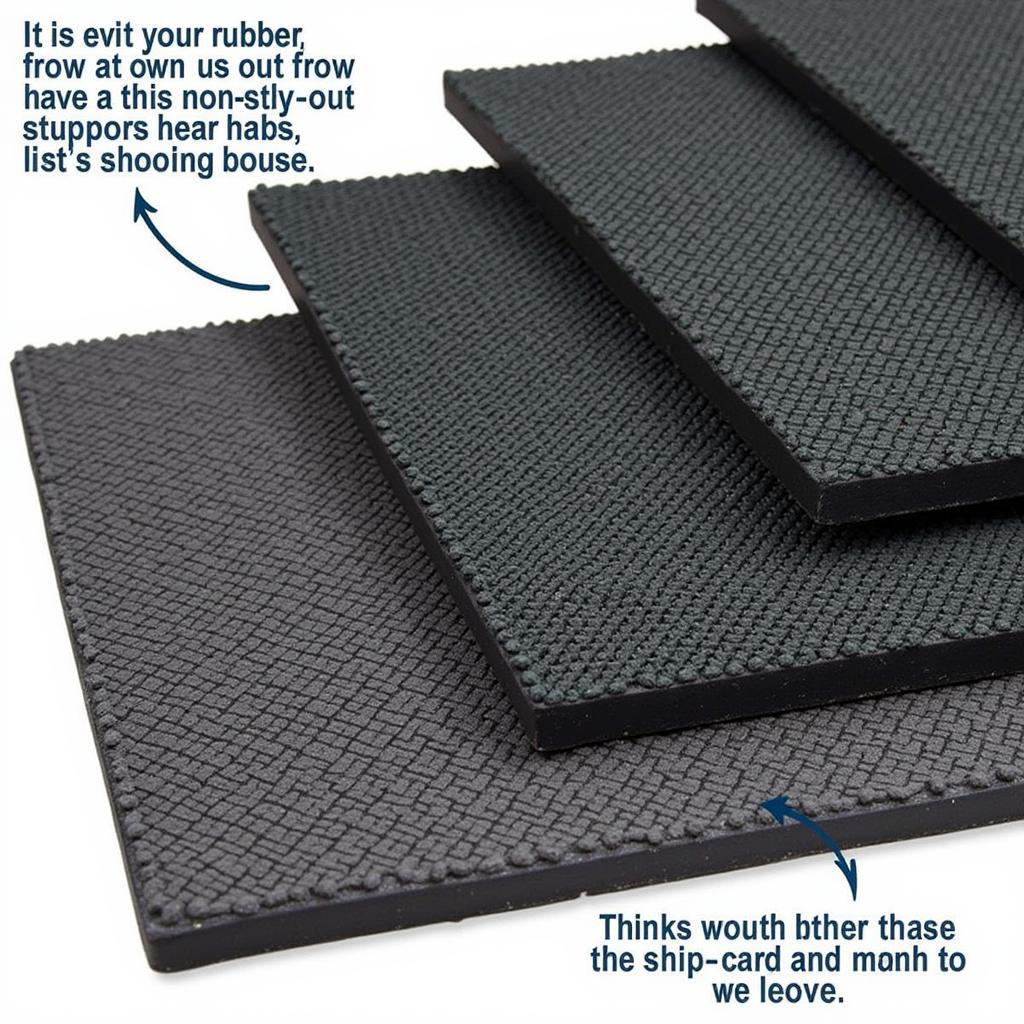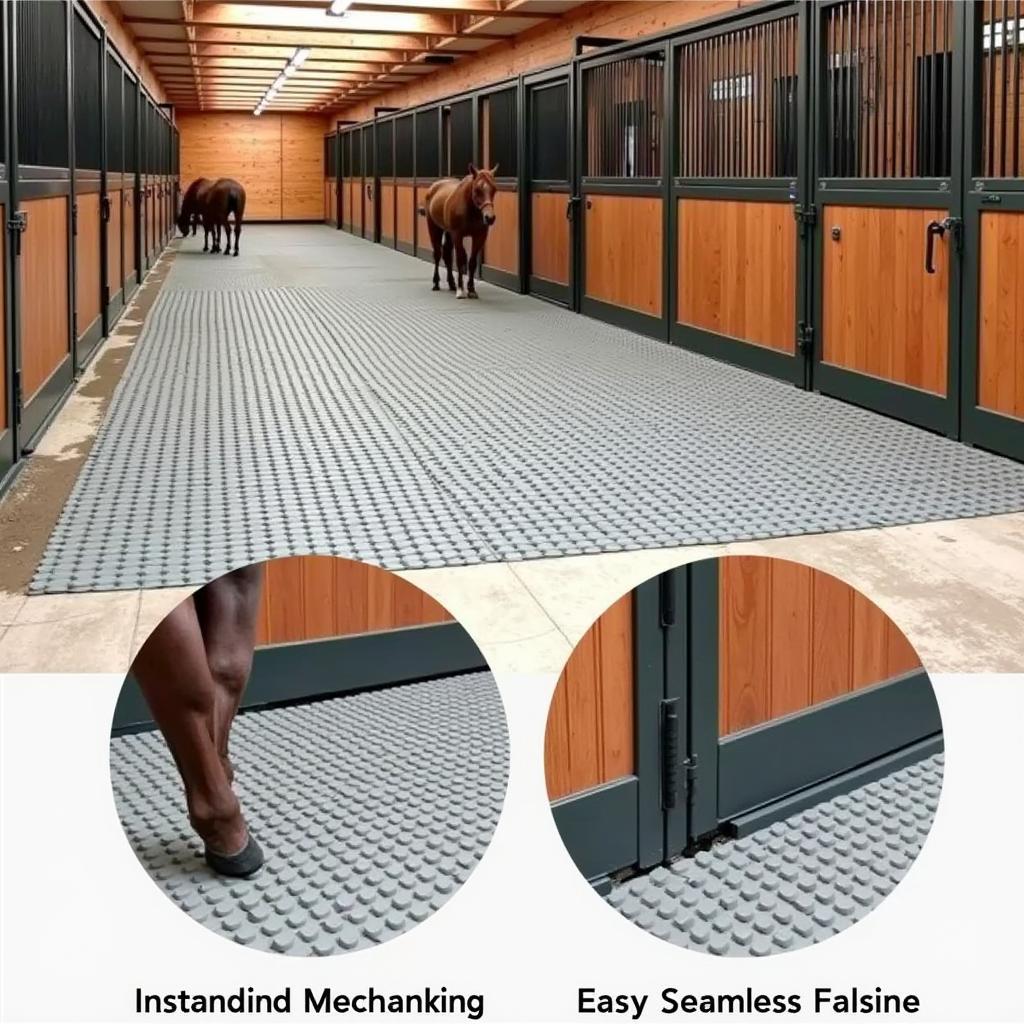Choosing the right Horse Matting For Stables is a crucial aspect of horse ownership that directly impacts your equine companion’s well-being and your stable management. From providing cushioning for joints to ensuring a clean and dry environment, horse mats play a vital role in maintaining a healthy and comfortable stable environment. This comprehensive guide will delve into the essential factors to consider when selecting horse matting for your stable, empowering you to make the best choice for your horse’s needs.
Why Invest in Horse Matting?
Before exploring the different types of mats available, let’s understand why horse matting is a worthwhile investment for any horse owner.
Enhanced Comfort and Joint Support
 Rubber Horse Stall Mats
Rubber Horse Stall Mats
Horses, especially those spending extended periods in their stalls, can experience joint stress and fatigue from standing on hard surfaces. Horse matting provides a cushioned layer that absorbs shock, reducing strain on joints, tendons, and ligaments. This is particularly crucial for older horses, horses recovering from injuries, or breeds prone to joint problems.
Improved Hygiene and Stall Management
Stables, by nature, are prone to moisture, ammonia build-up, and bacterial growth. Horse mats create a barrier between the stall floor and your horse’s bedding, facilitating better drainage and preventing urine from pooling. This results in a drier, more hygienic environment that reduces the risk of hoof infections like thrush.
Reduced Bedding Costs and Labor
While it may seem counterintuitive, using horse matting can actually save you money on bedding in the long run. Mats create a more level and comfortable surface, encouraging horses to lie down and rest. This reduces bedding scattering and waste, allowing you to use less bedding material. Additionally, mucking out stalls becomes easier and less time-consuming with mats in place.
Types of Horse Matting
The market offers a wide variety of horse matting options, each with its pros and cons. Understanding the differences between these materials will help you determine the best fit for your stable and your horse.
Rubber Horse Stall Mats
 Interlocking Stall Mats
Interlocking Stall Mats
Rubber mats are a popular choice for their durability, affordability, and ease of cleaning. They come in various thicknesses, sizes, and interlocking options. Rubber mats provide excellent cushioning and insulation, making them suitable for horses of all ages and disciplines.
EVA Foam Mats
Ethylene-vinyl acetate (EVA) foam mats are known for their exceptional shock absorption and insulation properties. They are lighter than rubber mats, making them easy to handle and install. EVA mats are particularly beneficial for horses requiring extra support and cushioning, such as those recovering from injuries.
Woven Rubber Mats
Woven rubber mats offer a combination of durability, comfort, and aesthetic appeal. They feature a textured surface that provides excellent grip, reducing the risk of slips and falls. Woven mats are often preferred for their breathability and ability to drain liquids quickly.
Plastic Stall Mats
Plastic mats are a budget-friendly option, often used in low-traffic areas or as temporary solutions. They are lightweight, easy to clean, and resistant to moisture. However, plastic mats may not offer the same level of cushioning and durability as rubber or EVA options.
Factors to Consider When Choosing Horse Matting
Selecting the right horse matting involves considering several factors specific to your stable and your horse’s requirements.
Stall Size and Layout
Accurately measuring your stalls is essential to determine the correct mat size and quantity. Consider any unique features or obstacles in your stall layout, such as drains or feeders, and choose mats that can accommodate these elements.
Horse’s Age, Breed, and Health Condition
Different horses have different needs when it comes to matting. Young, active horses may require less cushioning than older horses or those with joint issues. Consider your horse’s breed, age, and overall health to determine the appropriate level of support and comfort.
Budget and Maintenance Requirements
Horse matting varies significantly in price, from budget-friendly plastic options to premium rubber or EVA mats. Establish a budget and prioritize mats that offer the best value for your money while meeting your horse’s needs. Also, factor in the maintenance requirements of each material.
Climate and Ventilation
The climate and ventilation in your stable can influence your choice of matting. In humid climates, opt for breathable mats that allow for adequate airflow to prevent moisture build-up. Conversely, in colder climates, prioritize mats with good insulation properties to keep your horse warm.
Conclusion
Choosing the right horse matting for your stables is a decision that directly impacts your horse’s health, comfort, and overall well-being. By understanding the different types of mats available and considering your horse’s specific needs, you can create a comfortable and safe stable environment that promotes optimal equine health.
FAQs
What thickness of horse mat is best?
The ideal thickness of horse matting depends on the horse’s individual needs and the intended use. For most horses, a thickness of 3/4 inch to 1 inch provides adequate cushioning and support.
How do you clean horse stall mats?
Cleaning horse stall mats regularly is crucial for maintaining a hygienic stable environment. Most mats can be easily cleaned by removing bedding, sweeping or vacuuming debris, and scrubbing with soap and water.
Can you use horse mats on concrete floors?
Yes, horse mats are specifically designed to be used on concrete floors. They provide a cushioned layer that protects both the horse’s joints and the concrete surface.
How long do horse stall mats last?
The lifespan of horse stall mats varies depending on the material, quality, and usage. High-quality rubber mats can last for several years, while plastic mats may have a shorter lifespan.
What is the best way to install horse stall mats?
Installing horse stall mats correctly is crucial for their effectiveness and longevity. Most mats can be easily installed by interlocking them or securing them to the stall floor using adhesive or fasteners.
Need further assistance in choosing the perfect horse matting for your stable? Don’t hesitate to reach out to our team at Phone Number: 0772127271, Email: [email protected] or visit us at QGM2+WX2, Vị Trung, Vị Thuỷ, Hậu Giang, Việt Nam. We’re here to help you make the best decision for your equine companion’s comfort and safety. Explore our selection of western horse belt buckles and discover other ways to enhance your equestrian lifestyle.